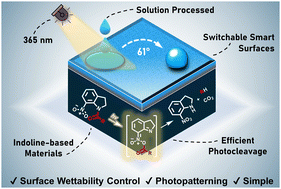Simple photocleavable indoline-based materials for surface wettability patterning†
Abstract
There is a continued interest for smart surfaces that can transition between being hydrophobic or hydrophilic on-demand. Surfaces that can be switched with light are highly attractive, where the wettability properties of the surface or photopatterned water channels can be remotely controlled. However, many existing systems are complex, rely on synthetically challenging materials, lack reproducibility, or involve costly and intricate fabrication methods. Here, we introduce a straightforward approach using indoline-based, small molecules for the simple and precise control of a surface's wettability, using UV light as the external trigger. The wettability transition is accomplished through the photocleavage of the o-nitroanilide moieties, resulting in substantial water contact angle changes of up to 61°. Simplicity is achieved through solution-based spin-coating for material deposition, while each of the photoproducts were investigated using UV-vis and NMR studies, concluding that photocleave was fast and efficient (both in solution and the solid-state). Each material showed complete thermal stability within their operational range, while the best performing materials, 7-OH and 9-OH, produced smooth, high-quality coatings (RMS 0.24 and 0.50 nm, respectively). Furthermore, we demonstrated their use for wettability patterning and water channel creation, highlighting the materials suitability for integration in smart surfaces. This work offers an extremely accessible pathway to develop light-activated responsive surfaces.



 Please wait while we load your content...
Please wait while we load your content...